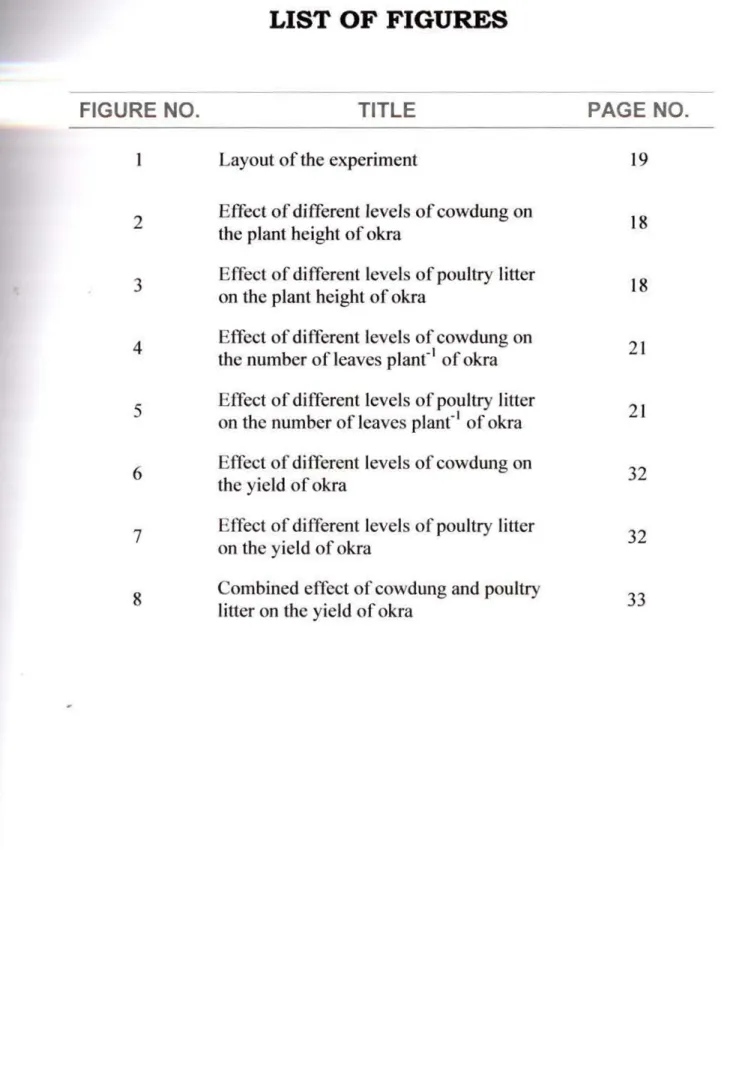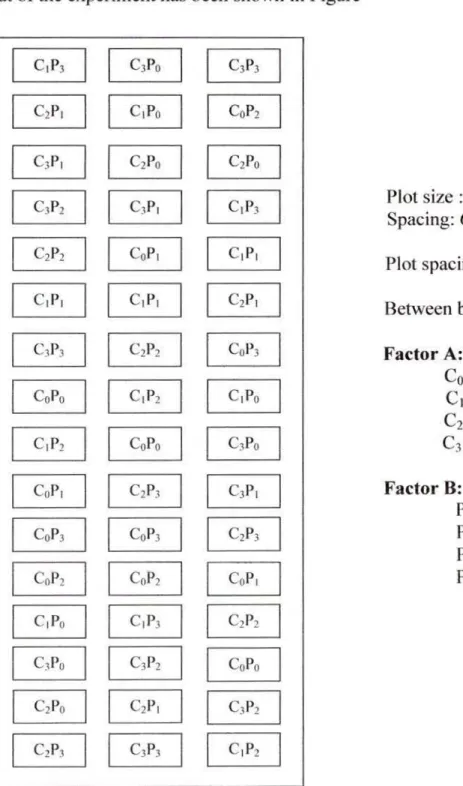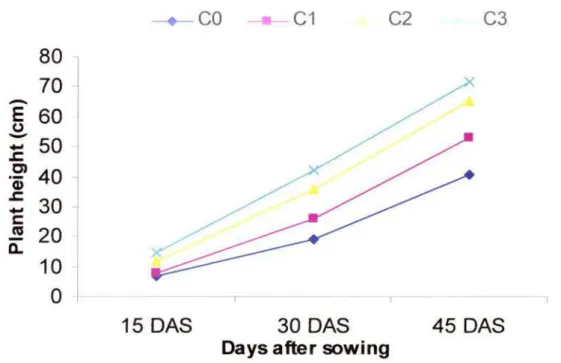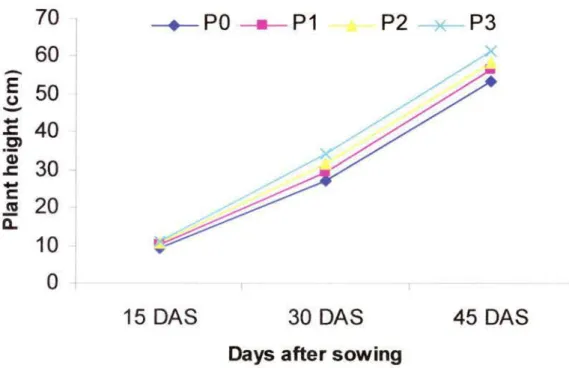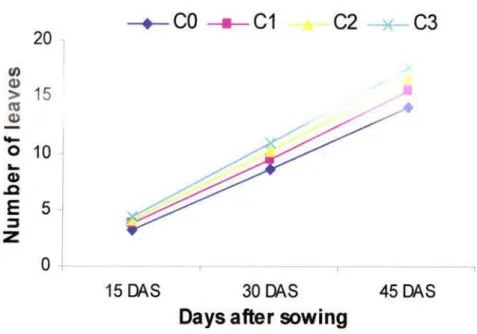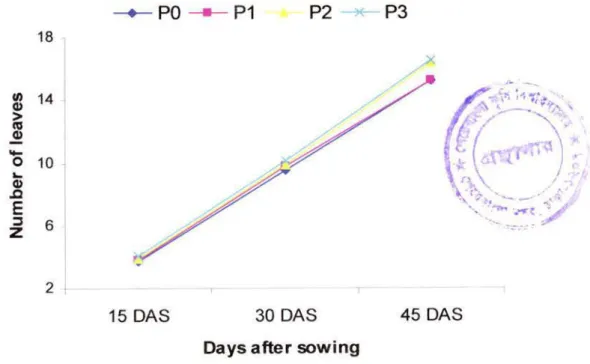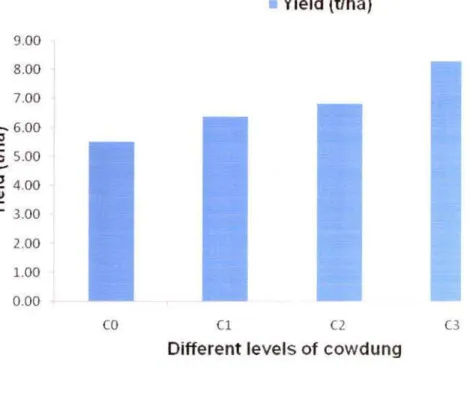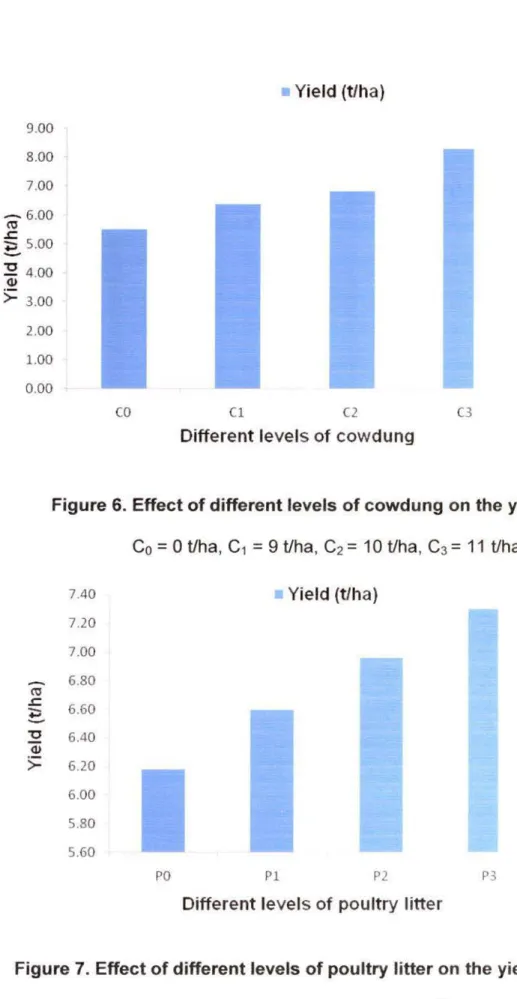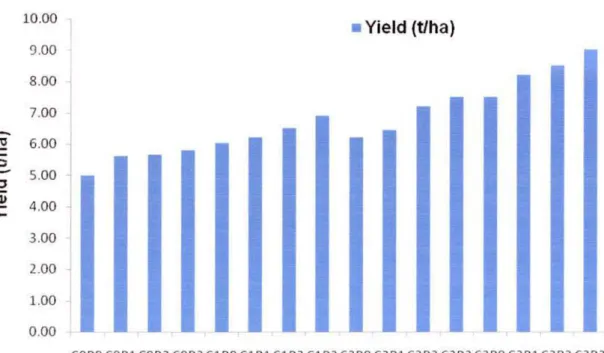December 2007
DEPARTMENT OF HORTICULTURE & POSTHARVEST TECHNOLOGY SHER-E-BANGLA AGRICULTURAL UNIVERSITY
DHAKA-1207 MD.SHAHNAWAZ
EFFECT OF COWDUNG AND POULTRY LITTER ON THE GROWTH AND YIELD OF OKRA (Abelmoschus esculeutuss
Prof. Md. Ruhul Amin Chairman
Examination committee
----
Prof. Md. Ruhul Amin
Dept. of Horticulture and Postharvest Technology Sher-e-Bangla Agricultural University
Dhaka-1207 Co-supervisor Prof. A. K.M. Mahtab Uddin
Dept. of Horticulture and Postharvest Technology Shcr-c-Bangla Agricultural University
Dhaka-1207 Supervisor
Approved by:
MASTER OF SCIENCE IN
HORTICULTURE
SEMESTER: JULY- DECEMBER, 2007 A Thesis
Submitted Lo the Dept. of Horticulture and Postharvest Technology, Sher-e-Bangla Agricultural University, Dhaka,
in partial fulfillment of the requirements for the degree
of BY
MD. SHAHNA WAZ Reg. No. 27451/00657
GROWTH AND YIELD OF OKRA (Abeln10sclws csculcntus) EFFECT OF COWDUNG AND POUL TRY LITTER ON THE
(<Professor. }f.'JG~. ~ali.ta6 Vcfcfin) Supervisor
(J)atecf:
(J)/iakJi, (Bangfatfesli
. ~
-
been availed'
of
durinq thecourse of tliis investigation
hascfu{y
beenacJlnow{ecfgecf.
I further
certify tliat sucfi lie{p or source of information,
ashas 7.fzis is to certify tfzat
thethesis
entitled,"f£P<FE.(Yr OP COrwDVWq _M{(J) POVL'l'CR..,<Y L1'1!I!E!i{ OW
Tiff, (}CR,_,OWI!J(_M{(J)
<YI<££(])OP
0'1(1?.fl." submitted
to
the<Faculty of Jlgricu[ture, Slier-e...(]3angfa Jfgricu{tura{
University,(J)/ia/la, in partial fu[fil[ment of tlie requirements for tlie deqree of
9d}fSPE~ OPSCIP9f(!E in JfO<R!J.]C'VL<TV~, embodies the result of a piece of bona jU{e researcb wor/l carried" out 6y
~(]). SJf)IJ{!J{JI'W)IZ, (J?sgistration Wo.
27451/00657under my supervision and' my guUfance.
Nopart of tlie tliesis lias been submitted for any
othercfegree or diploma.
jf_ 1( 5W ?dahta6 VrfrFn
<Professor
-Depertment of Jfort.icu(ture iS/., -Postliaroest Tecfinofogy
~ VJ
Sher-e <Banofa Jlgricuft.ura: 'L!niversi.ty~) - 7)-··---·-
The Author December, 2007
Ali praises are due to the Almighty ''Allah" Who kindly enabled the author to complete the research work and the thesis leading to Master of Science.
The author feels proud to express his profound respect, deepest sense of gratitude, heartful appreciation to Prof A. K. M Mahtab Uddin, Department of Horticulture and Postharvest Technology, Sher-e-Bangla Agricultural University, Dhaka for his constant inspiration, scholastic guidance and invaluable suggestions during the conduct of the research and for his constructive criticism and whole hearted cooperation during preparation of this thesis.
The author express his heartfelt gratitude and indebtness to Professor Md.
Ruhul Amin, Chairman ,Department of Horticulture and Postharvest Technology, Sher-e-Bangla Agricultural University, Dhaka for his assistance in planning and execution of the study and for his constructive instruction, critical reviews and heartiest cooperation during preparation of the manuscript.
The author also express his heartfelt thanks to Md Hasanuzzaman Akand, Associate Professor and Jasim Uddin, Lecturer of the Dept. of Horticulture and Postharvest Technology, Sher-e-Bangla Agricultural University, Dhaka for their help, valuable suggestions and encouragement during the period of study.
The author also express his special thanks to his elder brother K. M Akhtar Hossain for his cooperation and inspiration during preparation of this paper.
lastly, the author would like to acknowledge his heartiest gratitude to his parents, younger sister and friends Koly, Tuly, Rasel, Zia, Emu, Shahed, Obaidullah, Solaiman and all others whose blessings, inspiration and encouragement opened the gate and paved the way to his higher studies.
ACKNOWLEDGEMENT
An experiment was conducted to evaluate the effect of cowdung and poultry litter on the growth and yield of okra at the central farm of Sher-e-Bangla AgricuJtural University, Dhaka, Bangladesh during the period from April to July, 2007. The experiment was conducted with two factors, factor A: cowdung with different levels (C0= no manure.C,= 9 t/ha,C2= J 0 t/ha.C,« 11 t/ha) and factor B: poultry litter with different levels (P0= no rnanure.P,= 7 tlha,P2=8 t/ha.P,= 9 tlha). The two factors experiment was laid out in Randomized Complete Block Design (RCBD). The result of the experiment revealed that plant height, number of leaves per plant, leaf length, leaf breadth, petiole length, pod length, pod weight, number of pod per plant, pod yield per plant, pod yield per plot, pod yield per hectare were significantly influenced by the different levels or cowdung and poultry litter. The highest level of cowdung ( 11 ton/ha) produced the highest plant height (71.66 cm.), number of leaves (17.71), leaf length (18.70 cm.), leaf breadth (25.54 cm.), green pod yield/plot (2.98 kg), pod yield/ha (8.30 ton) while the lowest green pod yield/pot ( 1.98 kg), pod yield/ha (5.51 ton) were produced from control treatment. The highest
level of poultry litter (9 ton/ha) gave the highest plant height (61.73 cm.),
number of leaves (16.54), leaf length (17.14 cm.), leaf breadth (22.l3cm.), green pod yield/plot (2.62 kg), pod yield/ha (7.30 ton) and the lowest green pod yield/pot (2.18 kg), pod yield/ha (6.18 ton) were produced from control treatment. The combined effect of different levels of cowdung and poultry litter also found significant. The maximum plant height (76.88 cm.), number of leaves ( 18.16), leaf length ( 19.52 cm.), leaf breadth (26.48 cm.), pod yield/plot (3.24 kg), pod yield/ha (9 ton) was obtained from the treatment combination of C3P3 (application of 11 tlha cowdung with 9 t/ha poultry litter). The lowest pod yield/ha (5 ton) was recorded from C0P0 (where cowdung and poultry litter were not applied).
ABSTRACT
EFFECT OF COWDUNG AND POULTRY LITTER ON THE GROWTH AND YIELD OF OKRA (Abelmoschus esculentus)
CHAPTER TITLE PAGE NO.
ACKNOLOWLEDGEMENT 1
ABSTRACT II
CONTENTS Ill
LIST OF TABLES v
LIST OF FIGURES VI
LIST OF APPENDICES Vil
LIST OF ABBREVIATIONS Vlll
CHAPTER I INTRODUCTION I
CHAPTERU REVIEW OF LITERATURE 3
CHAPTER III MATERIALS AND METHODS 10
3. I Experimental site 10
3.2 Climate 10
3.3 Soil 10
3.4 Planting materials used in the experiment 10
3.5 Design of the experiment 1 1
3 .6 Layout of the experiment 11
3.7 Land preparation 13
3 .8 Application of manures 13
3.9 Sowing of seeds 13
3 .10 lntercuJtural operation 14
3.1 J Harvesting 15
3.12 Collection of data 15
3.13 Statistical analysis 16
CHAPTER IV RESULTS AND DISCUSSION 17
4.1 Plant height 17
4.2 Number of leaves per plant 19
4.3.Leaf length 22
4.4.Leaf breadth 23
4.5 Petiole length 27
4.6 Green pod length 27
4.7 Green pod diameter 28
4.8 Number of pods per plant 28
4.9 Individual pod weight 29
4.10 Pod yield per plant 29
CONTENTS
CONTENTS (Cont'd)
4.11 Pod yield per plot 30
4.12 Pod yield per hectare 31
CHAPTERV SUMMARY AND CONCLUSION 37
REFERENCES 43
APPENDICES 47
36 35 34
26
25
24
Combined effect of cowdung and poultry litter on yield and yield contributing characters of okra
6
Effect of poultry litter on pod length. pod diameter, pod weight, number of pod per plant, yield per plant and yield per plot of okra 5
Effect of cowdung on pod length, pod diameter, pod weight, number of pod per plant, yield per plant and yield per plot of okra
4
Combined effect of cowdung and poultry litter on the growth of okra
3
Effect of poultry litter on leaf length, leaf breadth and petiole length of okra
2
Effect of cowdung on leaf length, leaf breadth and petiole length of okra
I
PACE NO.
TITLE TABLE NO.
LIST OF TABLES
- --
FIGURE NO. TITLE PAGE NO.
Layout of the experiment 19
2 Effect of different levels of cowdung on the plant height of okra 18
3 Effect of different levels of poultry litter on the plant height of okra 18
4 Effect of different levels of cowdung on the number ofleaves plant" of okra 21
5 Effect of different levels of poultry litter on the number of leaves plant" of okra 21
6 Effect of different levels of cowdung on the yield of okra 32
7 Effect of different levels of poultry litter on the yield of okra 32
8 Combined effect of cowdung and poultry litter on the yield of okra 33
LIST OF FIGURES
49
Analysis of varience of the data on number of pod plant 1, pod length, pod breadth, pod weight, yield plant", yield plot" and yield hectare" of okra
IV
49
Analysis of varience of the data on plant height, number of leaves, leaf
length, leaf breadth and petiole length of okra
111
II.B Physical and chemical properties 48
of the Soil
11.A Morphological characteristic of 47 the Soil
Morphological, physical and chemical characteristics of initial soil (0 - 15 cm depth)
II
Monthly record of temperature,
I rainfall, relative humidity and sunshine 47 hours during the period from April,
2007 to July, 2007
APPENDIX NO. TITLE PAGE NO.
LIST OF APPENDICES
AEZ
BARI BBS DAS et al.
Etc
LSD
NS
RCBD SAU Agro-Ecological Zone
Bangladesh Agricultural Research Institute Bangladesh Bureau of Statistics
Days After Sowing and others
Etcetra
Least Significant Difference Non Significant
Randomized Complete Block Design Sher-e-Bangla Agricultural University
ABBREVIATION FULL WORD
ABBREVIATIONS
Jn Bangladesh vegetable production is not uniform round the year. Vegetables are plenty in winter, but are lower in summer. The total vegetable production, around 30% is produced during kharif season (April to September). and 70% is produced in Rabi season (October to March) (Anon., 1993). Though it is popular in the country, its production is mainJy concentrated during summer.
So, as vegetable okra can get an importance in summer. Total production of okra is about 19210 metric tones produced from 6210.53 hectare of land in the year 2003, and the average yield is about 3.093 t/ha (BBS, 2004), which is very low, compared to that of other developed countries where the yield is as high as Okra is a nutritious and delicious vegetable, fairly rich in vitamins and minerals. Per I 00 gm of edible portion of pod has moderate levels of vitamin A (0.0 I mg) and C ( 18 g), calcium (90 mg), phosphorus and potassium. The content of thiamine (0.07 mg), riboflavin (0.08 mg) and niacin (0.08 mg) per 100 g edible portion of pod is higher than that of many vegetables (Rashid, 1990). Tender pods have high mucilage content and are used in soups and gravies. The pods also have some medicinal value and a mucilaginous preparation from the pod can be used as a plasma replacement or blood volume expander.
.... ,~--:..
}INTROD UCT IO N ti (
02ficrtl
L GJmxw
og-/og Okra (Abelmoschus esculentus L.) is a member under Malvaceae familyid
also known as Lady's finger and Okra. It is an annual vegetable crop grown from seed in tropical and sub-tropical parts of the world (Thakur and Arora, 1986).). It is well distributed throughout the Indian sub-continent and East Asia (Rashid, 1990). Its tender green fruits are popular as vegetable among all classes of people in Bangladesh and elsewhere in the world.
CHAPTE .RI
• To study the effect of cowdung as organic source of nutrient on the growth and yield of okra.
• To determine the effect of poultry Jitter as organic source of nutrient on the growth and yield of okra.
• To find out the optimum level of cowdung and poultry litter for better growth and yield of okra.
Considering the above facts, the present research was under taken with the following objectives:
Different manures contain different amount of nutrient in different proportion and their mode of nutrient release is not same. So, different manures may influence the growth, yield in different angles.
Growth and yield of okra depend on nutrient avaiJability in soil, which is related to the judicious appJication of manures and fertilizers. Nutrient may be applied through two sources viz. organic and inorganic. Increased use of
inorganic fertilizer in crop production causes health hazards, creates problem to the environment including the pollution of air, water and soil etc. The continuous use of chemical fertilizer badly affects the soil texture, structure, color, aeration, water holding capacity and microbial activity of soil. A good soil has an organic matter content of more than 3%. But in Bangladesh soil of most region have less than 1.5%, some soil have less than l % organic matter.
For continuous cropping, organic manures applied to the crop fields through cowdung, poultry litter, farmyard manure etc. are insufficient. Now a days, gradual deficiency in soil organic matter and reduce yield of crops are alarming factors and burning issues for the farmers and agriculturists. All efford should be made to develop consciousness of the farmers about the importance of soil organic matter in the long term maintainance of soil productivity. In recent year poultry and livestock farming are increasing. So manure like poultry litter, cowdung etc. are becoming available.
Wright ( 1960) studied that Horse and Cow manure contains approximately 0.5% N, 0.55% K and 0.25 % Phosphoric acid. It thus supplies three of main elements needed by fruit plants.
The organic matter is called the life of the soil. Fertility of particular soil is determined by the presence of organic matter. The organic matter contents of soil vary from 0-5% and it depends on several factors like origin of soil, climatic conditions, vegetation, microbial activities etc. The physical, chemical and biological properties of soil are greatly influenced by organic matter.
Although, organic matter contain all the essential plant nutrients, but after application of organic manures required time to convert its available form to the plant. That is why the response of crops to organic manure is low. But due to the residual and beneficial effects on soil properties, applications of organic manures are encouraged. Some available information about the effects of organic manures on growth and yield of okra are reviewed here.
Effect of Cowdung and Poultry litter on the growth and yield of okr a:
Okra is one of the most important vegetables in Bangladesh, as well as in the world. Researches on various aspects of its production technology have been carried out worldwide. Among these researches, very few numbers of works were reported where the effect of cowdung and poultry manure was studied.
However, some of the researches and their findings related to the present study carried out at home and abroad are reviewed in this chapter under the following headings.
REV IEW OF LIT ERAT UR E
CHAPTER I I
Edmond et al. ( 1977) reported that organic matter increased the pore space of the soil and thus improved the rate of gas exchange. Application of compost to the soil increased water-holding capacity, reduced soil erosion and improved Gaur et al. (1971) found that FYM and organic residues were effective in increasing the level of organic matter even under tropical conditions.
In Rajasthan, at Udaipur, Verma et al. (1970) recommended the application of 90 kg N and 80 kg P and l 0 tones of farmyard manure per hectare during kharif season for improving the qualitative and quantitative yield of okra.
Under coimbatore conditions, Kamalanathan et al. (1970) recommended 40 kg N and 30 kg K per hectare along with 25 tones of farmyard manure at the time of soil preparation.
Kamaluddin ( 1968) reported that organic manure increases soil organic matter and essential nutrient elements for plants.
Palevich (I 965) observed that nitrogenous fertilizer and organic manure improved total yield, weight per fruit, size of fruit and height of plants. He also reported that cowdung manure application in addition to N and P fertilizers significantly increased yield by 14-41 % in comparison with plots that received the same amount of N and P but without manure.
Dumitrcscu ( 1960) from his experiment on "Composts as organic manures
or
high fertilizing value" reported that application of poultry manure at the rate of 20 t/ha gave higher total yield.
YawaJkar et al. (1962), who recommended 8 tones of farm yard manure, 45 kg N, 22 kg each of P and K per hectare for the production of2725 kg green fruits.
Hochmuth et al. (1993) conducted an experiment to investigate the response of cabbage yield, head quality and leaf nutrient status to poultry manure fertilization. They reported that the marketable yield of cabbage responded quadratically to increasing rates of poultry manure during 1990, with the maximum yield (28.4 t/ha) being obtained by 18.8 t/ha. Yield recorded with 1.0 to 1.4 of conventional NPK fertilizer/ha were same as those with the highest rate of manure. The result showed that manuring efficiency was initially higher with commercial fertilizer than the poultry manure alone.
Kabir (1998) carried out an experiment at the Horticultural Farm, Bangladesh Agricultural University, Mymensingh to find out the effect of poultry manure and cowdung in presence and absence of chemical fertilizer on growth and yield of cabbage and reported that combination of poultry drops and inorganic fertilizer performed the best.
Farid et al. ( l 998) conducted an experiment at Joydebpur to study the efficiency of poultry manure and cowdung alone and in combination with mineral fertilizers on the yield of cabbage(var. Atlas-70).They mentioned that the head yield was increased both by cowdung and poultry manure with macro and micro nutrients added to the treatments. But the increase due to poultry manure was always higher than that of cowdung. Poultry manure alone increased the yield significantly when it was applied at the rate of 20 t/ha.
Cheung and Wong (I 983) carried out an experiment on animal manures and
sewage sludges for growing vegetables and stated that chicken manure and pig manure resulted in better growth than sewage sludges.
the physio-chemical and biological condition of the soil besides providing with plant nutrients.
Prezotti et al. ( 1988) suggested that organic manure applications increased total productivity by 48% and improved the proportion of large fruits in the total yield.
An experiment was carried out by Zarate et ai. ( 1997) in Brazil to evaluate the rates and methods of application of poultry manures on lettuce. The soil was supplied with 0, 7 or 14 t semi-rotted poultry manure incorporated into the soil and 0, 7 or 14 t semi-rotted poultry manure applied to the soil surface. They found in the absence on incorporated manure, surface application of 14 t manure/ha gave significantly higher yield(l 7.8 t fresh matter/ha) than other nutrients. When 7 t/ha was incorporated, the rate of surface application had no significant effect on yields(13.3-17 t/ha),where as when 14 t/ha was incorporated, surface application of 7 t/ha manure gave the significantly highest yields (20 t/ha fresh matter)
Flynn et al. ( 1995) carried out an experiment to evaluate the suitability of composted broiler chicken manure as a potting substrate using lettuce plants.
They mentioned that the broiler manure containing peanut hulls as breeding materials was composted and then combined with a commercially available potting substrate. Highest fresh weight yield was obtained when broiler chicken litter compost was mixed with commercially available potting substrate at 3: I ratio. There was no evidence of physiological disorders resulting from excessive nutrient concentration.
Krupk.in et al. (1994) made an investigation using poultry manure, mixture of poultry manure plus hydrolysis lignin, and a compost of poultry manure plus hydrolysis lignin as organic fertilizers for potatoes, carrots. cabbage etc. with and without irrigation . Ihe result showed that these organic lcrtilizcrs improved the yield and quality of the crops, especially on soil having a low content of nitrate N, but had only little effect on soils well supplied with nitrate N.
Patil et al. (2000) conducted an experiment to develop a composite technique to produce quality okra pods for export purposes by using organic manures, biofertilizers and biopesticides. The three highest pod yields (128.59, 125.42 and 125.17 q/ha) were recorded from 75 kg N/ha + biofertilizer + FYM, 50 kg N/ha + biofertilizer + FYM and 75 kg N/ha + FYM, respectively. Although crops sown at the 30 x 15 cm spacing recorded the highest yield (118.23 q/ha), Naidu et al. ( 1999) conducted a study on a medium black soil at the Maharajpur vegetable research farm in Mabalpur, Madhya Pradesh, India during spring-summer seasons of l 996-97, 1997-98 and 1998-99 to evaluate the effect of manures, bio- and chemical fertilizers on the soil microbial population and growth and yield of okra. The treatments used in the experiment were: (T1) control; (T2) NPK (80:60:50)+20 tones farmyard manure (FYM)/ha;
(T3) 55 kg N+35 kg P205+25 tones FYM/ha; (T4) 25 kg P205+70 kg K20+9 tones poultry manure; (T 5) I 0 kg P205+ 3 tones vermicompost /ha; (T 6) 12 K20+20 tones FYM+4 tones poultry manure/ha; (T7) 20 tones FYM+l4 tones vermicompost/ha; (T8) 90 kg K20+7.5 tones poultry manure+I.O tonne vermicornpost/ha; (T 9) 35 tones FYM + Azospirillum + phosphorus solubilizing bacterium (PSB); (T10) I 0 tones poultry manure/ha + Azospirillum +PSB; (T11) 3 tones vermicompost + Azospirillum +PSB; and (T12)
Azospirillum+PSB. Results showed that plant height, number of leaves per plant, number of nodes per plant, internodal length, number of fruits per plant, weight of fruits per plant and fruit yield were maximum under T 2. On the other hand, crude protein percentage was highest Linder T 8. The maximum net income of Rs. 19089 along with a 0.02 benefit: cost ratio was obtained under T2.
Rue (1998) carried out an experiment by using compost, obtained from dairy manure and municipal solid waste to find out the beneficial effects on broccoli.
He found beneficial effects on growth. yield and nutrient component with compost application in the broccoli production.
Bhadoria et al. (2002) conducted field experiments in 1997-98 and 1998-99, in Kharagpur, West Bengal, India to investigate the effect of organic manure in improving the quality of rice (autumn crop) and okra (spring crop). Treatments consisted of: farmyard manure (FYM); FYM + microbial culture (FYM + MC);
chemical fertilizers (CF); processed city waste (PCW); oil cake pellets (OCP);
and vermicompost (VC). Among the different treatments, FYM produced the Raj and Kumari (200 I) reported that the effect of farmyard manure (FYM; 12 t/ha) and Azospirillum Inoculation (I kg/ha), singly or In combination (1: I) with other organic amendments (neem cake, green leaf, and enriched compost), on the yield and quality of okra cv. Arka Anamika, was studied in Vellayani, Kerala, India, from January to May 1998. All treatments were applied as basal dressing. All organic manures except FYM alone were superior to the control (recommended fertilizer of 12 t FYM/ha+50:8:25 N:P:K kg/ha) with respect to yield.
Bandyopadhyay (200 l) conducted an experiment to evaluate the effect of polythene and organic mulching under different levels of manuring practices of growth and yield of okra. Okra cv. Parbhani Kranti plants were subjected to different mulching (using green leaves of Antigonon leptopus or polyethylene sheets) and fertilizer treatments (oilseed cake and/or NPK at 25:25:25 or 50:25:25) in a field experiment conducted in India during the kharif season. The highest pod yield ( 171.92 q/ha), cost:benefit ratio ( 4.86) and growth attributing characters were observed with 10 t FYM/ha + 50:25:25 kg NPK/ha under the green leaves of A. leptopus. ln general, green leaf mulching was better and cheaper than polythene mulching.
the 30 x 30 cm spacing resulted in comparable yields (117 .13 q/ha). The application of biofertilizer (I litre slurry) + FYM + 50 kg N/ha was beneficial for obtaining higher } ields ( l 28.59 q/ha) of export quality pods ( 5- 7 cm in length) when harvested on alternate days, compared to their individual application.
Singh et al. (2004) studied that the integrated use of organic and inorganic sources of nutrients and biofertilizers increased the N, P and K concentrations in the plants (including fruits) of okra, pea and tomato. The integrated nutrient
management also significantly increased shoot dry matter yield of tomato and fruit yields of okra and tomato.
.
.increase m manure.
Ferreira et al. (2002) reported that the use of organic and mineral fertilizer for
production of okra was evaluated in northern Rio de Janeiro, Brazil, 1998-99.
Doses of 0, 10, 20, 30, and 40 t manure/ha were applied with or without NPK fertilizer. A significant increase in yield with mineral fertilizer was observed during both years. A significant increase in yield was also obtained with treatment.
best rice cooking and milling quality, and the best okra nutritional quality. The protein content and total minerals of okra fruit increased under the FYM
3.4 Planting materials used in the experiment
The okra variety used in the experiment was "BARI Dherosh 1" which is resistant to yellow vein mosaic virus, a severe disease of okra. The crop is a 3.3 Soil
The experimental site was located in the Modhupur Tract (AEZ-28) and it was a high land with adequate irrigation facilities. The soil texture was silty clay with a pH 5.6. Soil samples of the experimental plot was collected from a depth of 0 to 30 cm before conducting the experiment. Soil analyzed in the Soil Resources Development Institute (SRDI) Farmgate, Dhaka. have been presented in (Appendix ll).
3.2 Climate
The experimental area was under the sub-tropical climatic zone which was characterized by heavy rainfall during Kharif season (April to September) and scanty in the Rabi season (October to March). There was no rainfall during the month of December, January and February. The average maximum temperature during the period of experiment was 33.03°C and the average minimum temperature was 25.18°C. Details of the meteorological data in respect of temperature, rainfall and relative humidity during the period of the experiment were collected from the Meteorological Department of Bangladesh, Agargaon , Dhaka-1207 (Appendix I).
3.1 Experimental site
The experiment was conducted at the Central Farm of the Sher-e-Bangla Agricultural University, Dhaka during the period from April to July 2007. The site was located in 90.2°N and 23.5°E latitude. The altitude of the location was 8.2 m from the sea level (The Meteorological Department of Bangladesh, Agargaon , Dhaka-1207).
CHAPTER III
MATERIALS AND METHODS
3.6 Layout of the experiment
The whole field was divided into three blocks and each block consisted of 16 plots. Thus the total numbers of plots were 48. The size of unit plot was 3 .6m2 Total l 6 treatment combinations were as follows:
3.5 Design of the experiment
The field experiment was conducted by Randomized Complete Block Design (RCBD) with three replication. Two factors were used in the experiment viz.
four levels of cowdung and four levels of poultry litter.
Factor-A: Four levels of cowdung
C0: Control (No cowdung application)
C 1: 9 ton /ha (contain 90 kg N, 45 kg P and 99 kg K) C2: 10 ton /ha (contain 100 kg N, 50 kg P and I IO kg K) C3: 11 ton /ha (contain 110 kg N, 55 kg P and 121 kg K)
Factor-B: Four levels of Poultry litter
P0: Control (No poultry litter application)
P1: 7 ton /ha (contain 77 kg N, 35 kg P and 91 kg K) P2: 8 ton /ha (contain 88 kg N, 40 kg P and 104 kg K) P3: 9 ton /ha (contain 99 kg N, 45 kg P and 117 kg K)
high yieJding variety developed by the Vegetable Division of HorticuJture Research Center, Bangladesh Agricultural Research lnstitute (BARI) and released for commercial cultivation in 1996 ( H/\Rl.2004 ). I he seeds were collected from the 1 lorticulturc Research Center, l3angladcsh Agricultural Research Institute (BARI), Joydebpur, Gazipur.
Layout of the experiment has been shown in Figure
w
C1P3
I I
C3PoI I
C3P3s+
NC2P1
I I
C1PoI I
CoP2 EC3P1
I
C2Po C2PoC3P2
I
C3P1 C1P3 Plot size : 3 m x 1.2 m Spacing: 60 cm x 50 cm C2P2I
CoP1 C1P1 Plot spacing: 50 cmC1P1
I
C1P1 C2P1 Between block: Im C3P3I I
C2P2 CoP3 Factor A: CowdungCo= Control Co Po
I
C1P2 C1Po C2= C1= 10 9 ton /ha ton /haC1P2
I
CoPo C3Po C3= 11 ton /haCoP1
I
C2P3 C3P1 Factor B: Poultry litter Po= ControlCoP3
I
CoPJ C2P3 P1= 7 ton /haP2 = 8 ton /ha
CoP2
I I
CoP2 CoP1 P3 = 9 ton /haC1Po
I
C1P3 C2P2C:iPo
I
C3P2 Co PoC2Po
I
C2P1 C3P2C2P3
I
C3P3 C1P2Figure I. Field layout of the experiment in the Randomized Complete Block Design (RCBD)
(Jm> l .2m). A distance of 0.5 m between the plots and 1.0 m between the blocks were kept. The treatment was randomly assigned to each of the block.
Each unit plot had 2 rm' s and each '' ith 6 plants. Lach plot contains 12 plants.
Plant to plant distance was 50 cm and row to row distance was 60 cm.
3.9 Sowing of seeds
The okra seeds of cv. BARI Dherosh I were sown on I 5th April, 2007 in rows of raised beds. Row to Row and plant to plant spacing were maintained 60 cm and 50 cm respectively. Three seeds were sown in each location. Then the seeds were covered with fine soil by hand and the field was irrigated lightly immediate after sowing.
1.1
1.1 l.3 0.5
0.5 Cowdung
Poultry litter Source: SRDI
%K
%P
%N 3.8 Application of manures
The doses of organic manures were fixed in such a way that the total available N,P and K were almost same as suggested by Rashid (1990). Rashid suggested Cowdung I 0 t/ha, Urea J 50 kg/ha, TSP I 00 kg/ha and MP 150 kg/ha which release 169 kg N, 70 kg P and 185 kg K (Cowdung contain 1%N, 0.5%P and l.1%K). For this, cowdung 9 t/ha (contain 90 kg N, 45 kg P and 99 kg K) and poultry litter 7 t/ha (contain 77 kg N, 35 kg P and 91 kg K) were used in the experiment and combinedly they release 167 kg N, 80 kg P and 190 kg K which were near about same in amount as Rashid suggestion. All type of manures were applied during final land preparation as basal dose.
Nutrient status in Cowdung and Poultry litter was as follows 3. 7 Land preparation
The land which was selected to conduct for the experiments was opened on 12th April, 2007 by a disc plough to open direct sunshine to kill soil born pathogens
and soil inhabitants insects. Ihe land was ploughed and cross-ploughed with a power tiller followed by laddering to break up the soil clods to obtain unit good tilth and to level the land. The weeds, crop residues and stables were removed from the field. After final land preparation the experimental plot was laid out, and the edge around each unit plot was raised to check run out of the nutrients.
Plant protection measure
For controlling shoot and pod borer mechanical control was adopted (hand
picking). For controlling yellow vein virus plant was uprooted and destroyed by fire as soon as the symptom found in the field.
Drainage
Stagnant water was effoctively drained out at the time of heavy rain.
Irrigation
A week after Sowing the requrement of irrigation was envisaged through visual estimation. Wherever the plants of a plot had shown the symptoms of wilting the plots were irrigated on the same day with a hosepipe until the entire plot was proper! y wet.
Thinning
Five to six days after germination only healthy seedling was kept to grow in each location and other seedling were removed.
Weeding
Significant number of weed were found and weeding was done three times in these plots where it was necessary.
Gap filing
Dead, injured and weak seedlings were replaced by new vigour seedling from the stock kept on the border line of the experiment.
3.10 Intercultural operations
The seedlings were kept under close observation and necessary intercultural operations were done through the cropping season for proper growth and development of the plant.
Petiole length (cm)
Petiole length was measured in centimeter (cm) by a meter scale at 15, 30 and 45 days after sowing (DAS) from the point of attachment of the leaf.
Leaf breadth (cm)
Leaves of selected plants were detached and leaf diameter was taken from one margin to another margin of the leaf and measured in centimeter (cm) by a meter scale at 15, 30 and 45 days after sowing (DAS).
Leaf length (cm)
Leaves of ten ( 10) randomly selected plants were made detached and measured in centimeter (cm) by a meter scale at 15, 30 and 45 days after sowing (DAS).
Number of leaves per plant
Number of leaves per plant of ten randomly selected plans was counted at 15, 30 and 45 days after sowing (DAS). The smallest young leaves at the growing point of the plant were excluded from counting. Calculating the average number of leaves, the average number was recorded.
Plant height (cm)
Plant height was measured from the base to the tip of the longest leaf at 15, 30 and 45 days after sowing (DAS). A meter scale was used to measure the plant height and expressed in cm.
3.12 Collection of data
Data were recorded from each plot on the following parameters from the sample plants during experiment. Ten (10) plants were randomly selected from each unit plot for the collection of per plant data.
3.11 Harvesting
Green pods were harvested at 2 day interval when they attained edible stage (i.e. the tender young pods of 8-13 cm long). Green pod harvesting was started from 4, June and was continued up to 20 July.
The collected data on various parameters were statistically analyzed using MST A TC package program. The mean for all the treatment was calculated and analyses of variances of all the characters were performed by F-variance test.
The significant of difference between the pairs of treatment means was evaluated by the Least Significant Difference (LSD) test at 5% and at l % levels of probability (Gomez and Gomez, 1984).
3.13 Statistical analysis
Green pod yield per hectare (t)
Green pod yield per hectare was calculated in ton by converting the mean green pod yield per plot.
Green pod yield per plot (kg)
Mean weight of edible green pods of 10 plants from each plot was measured in kilogram (kg).
Weight of individual green pod (gm)
Weight of individual green pod collected from the selected plants was measured in gram (g) with the help of an electrical baJance.
Green pod yield per plant (gm)
Weight of total green pod collected from each selected plant was measured in gram (gm) with the help of an electrical balance.
Number of green pods per plant
Mean number of green pods of selected plants from each plot was recorded.
Green pod diameter (cm)
Mean diameter of 10 randomly selected pods from each plot were measured in cm with the help of slide calipers.
Green pod length (cm)
Ten randomly selected pods from each plot were taken and length was recorded by a meter scale in cm and finally mean was calculated.
Application of poultry litter showed highly significant influence on the height of plant at 15, 30, and 45 DAS. At 15 DAS, the highest plant height (11.35 cm) was obtained from P3 and the shortest plant height (9.26 cm) was obtained from control (no manure) treatment. At 30 DAS, the highest plant height (34.55 cm) 4.1 Plant height
Application of cowdung exhibited a significant influence on the height of plant at 15, 30, and 45 DAS. Different levels of cowdung showed highly significant influence on plant height. At 15 DAS, the tallest plant height (14.66 cm) was obtained from C3 (cowdung 11 t/ha) whereas the shortest plant height (6.46 cm) was obtained from control (no cowdung) treatment. At 30 DAS, the tallest plant height ( 41.99 cm) was obtained from C3 and the shortest plant height (19.28 cm) was obtained from control (no cowdung) treatment. At 45 DAS, the tallest plant height (7 l.66 cm) was obtained from C 3 while the shortest plant height (40.72 cm) was obtained from control (no manure) treatment (Figure 2).
1t was revealed that plant height was increased with the increased of cowdung.
This could be due to promote of nitrogen uptake which enhanced vegetative growth of okra plants.
The experiment was conducted to observe the effect of organic sources of nutrient (Cowdung and Poultry manure) on the growth and yield of okra. A summary of the analysis of variance of all the characteristics studied with their sources of variance and corresponding degrees of freedom have been shown in appendix iii. Data on different parameters were analyzed statistically and the result has been presented in tables, graphs and figures. The results of the present study have been presented and discussed and possible interpretations have been made under the following headings.
R ESULT S AND DI SCUSSION
CHAPTER IV
Days after sowing
Figure 3. Effect of different levels of poultry litter on the plant height of okra
45 DAS 30 DAS
15 DAS
10
0
• PO • P1 • P2
"""*-
P370
60
5
50- l: 40 .2>
~ 30
-
r::.!! 20
Q.
Co= 0 t/ha, C1 = 9 t/ha, C2 = 10 t/ha, C3 = 11 t/ha 30 DAS
Days after sowing
Figure 2. Effect of different levels of cowdung on the plant height of okra
45 DAS 15 DAS
10 0
-
E 60=
0 50s:
.2>
G) 40=
c: 30.!! 20
Q.
80 70
C2 C3
• C1
.. co
was obtained from P3 and the shortest height (27.05 cm) was found from control treatment and at 45 DAS, the highest height (61.73 cm) was obtained
4.2 Number of leaves per plant
Application of cowdung exhibited a significant influence on the number of leaves per plant at 15 DAS, 30 DAS and 45 DAS. At 15 DAS, the highest number of leaves ( 4.41 ) was recorded from C3 and the lowest number of
leaves (3.24 ) was recorded from control treatment. At 30 DAS, the highest number of leaves (I 0.94) was obtained from C3 and the lowest number of leaves (8.66) was recorded from control treatment. At 45 DAS, the maximum number of leaves (17. 71) was obtained from C3 and the minimum number of leaves ( 14.09) was recorded from control treatment (Figure 4 ). It was revealed that the number of leaves per plant increased with the increased in cowdung application. This might be due to P, K concentration was increased with the increase of cowdung which has significant role in photosynthesis, storage energy, cell division and cell enlargement that enhanced the number of leaves.
The plant height was significantly influenced by the treatments of cowdung and poultry litter combination at 15, 30 and 40 DAS. At 15 DAS, the longest plant height (15.67cm) was obtained from C3P3 and the shortest height (6.47 cm) was recorded from control treatment. At 30 DAS, the longest plant height (47.46 cm) was obtained from C3P3 while the shortest plant height (16.68 cm) was found from control treatment. At 45 DAS, the longest plant height (76.88 cm) was obtained from C3P3 where as the shortest plant height (37.38 cm) was recorded from control treatment (Table 3). It was revealed that plant height increased with the increased in the application of cowdung and poultry litter.
This result was due to increase ofN, P and K concentration in the plant of okra.
Thus manure improved plant height which was supported by Singh et al.
(2004), Cheung and Wong (1983) and Palevich (1965).
from P3 where as the shortest height was (53.58 cm) was obtained from control treatment (Figure 3). With the increasing of poultry litter the plant height was also increased. This might be due to influence on nitrogen uptake which helped in' cgciativc grow th.
Interaction between cowdung and poultry litter showed significant influence on number of leaves per plant at 15, 30 and 40 DAS. At 15 DAS, the maximum the highest number of leaves (4.83) was obtained from C3P3 and the minimum the minimum number of leaves (3.0 l) was found from control treatment. At 30 DAS, the highest number of leaves ( l l.53) was obtained from C3P3 while the lowest number of leaves (8.16) was recorded from control treatment. At 45 DAS, the maximum number ( 18.16) of leaves per plant was obtained from C3P3
treatment and the minimum number was ( 12.63) was obtained from control treatment (Table 3 ). The result revealed that the number of leaves per plant difTered significantly due to the application of different level of cowdung and poultry litter. Naidu et al. ( 1999) found the same result while conducted a study to evaluate the effect of manure.
Application of poultry litter showed highly significant influence on the number
of leaves per plant at 15. 30. and 45 DAS. At 15 DAS, P3 showed the maximum number of leaves (4.0R) and control treatment showed the minimum
number (3.69) of leaves. At 30 DAS, P3 showed the maximum number of leaves (10.13) and control treatment showed the minimum number of (9.51) leaves. At 45 DAS, P3 showed the maximum number of (16.54) leaves where as control treatment showed the minimum number (15.24) of leaves (Figure 5 ).
There the number of leaves per plant was increased with the increase of poultry litter. This might be due to increase of nutrient concentration that influenced photosynthesis and cell expansion.
Figure 5. Effect of different levels of poultry litter on the no. of leaves plant" of okra
-+-PO --- P1
•
P2 P318
...J'
"'
14Cl) >
"'
....
Cl)0 10
....
.c Cl)
E :::s 6
z
2
15 DAS 30 DAS 45 DAS
Days after sowing
Figure 4. Effect of different levels of cowdung on the no. of leaves plant" of okra
Co= 0 t/ha, C1 = 9 t/ha, C2 = 10 t/ha, C3 = 11 t/ha
-+-CO ---c1
... C2
~C3
20
"'
Q)
..
> 15 ~
('O
•
....
Q)0 10
....
Q) .Q
E 5
::::J
z
0
15 DAS 30DAS 45 DAS
Days after sowing
Cowdung and poultry litter combinedly performed significant effect on the leaf length of okra plant at 15, 30 and 45 DAS. The longest leaf length was found with increasing of level of cowdung and Poultry litter. At 15 DAS, the longest leaf length ( l 2.21 cm) was recorded from C3P3 where as the shortest length (5.65 cm) was obtained from control treatment. At 30 DAS, the longest leaf length ( 16.95 cm) was recorded from C3P3 while the shortest length (8.46 cm) was recorded from control treatment. At 45 DAS, the longest leaf length ( 19.52 cm) was recorded from C3P3 treatment and the shortest length (11.61 cm) was There had a significant influence of poultry litter on okra plant in respect of leaf length at 15, 30 and 45 DAS. At 15 DAS, the longest leaf length (9.83 cm) was recorded from P3 and the shortest length (8.50 cm) was recorded from control treatment. At 30 DAS, the longest leaf length ( 14.13 cm) was recorded from P3 where as the shortest length (12.20 cm) was recorded from control treatment. At 45 DAS, the highest leaf length (17.14 cm) was obtained from P3 treatment and the lowest length (15.39 cm) was obtained from control treatment (Table 2). It was found that leaf length was increased with the increased of poultry litter. This might be due to increase in nitrogen concentration which stimulated leaf length.
4.3 Leaf length
Cowdung had a significant influence on the length of leaves of okra plants at 15. 30 and 45 DAS. At 15 DAS, the longest leaf length ( 11.29 cm) was
recorded from C_, where U\ the shortest length (6.30 cm) was obtained from control treatment. At 30 DAS, the longest leaf length ( 16.25 cm) was recorded from C3 while the shortest length (9.48 cm) was found from control treatment.
At 45 DAS, the highest leaf length was recorded (18.70 cm) from C3 treatment and the minimum length was recorded (12.74 cm) from control treatment (Table I). It was revealed that leaf length was increased with the increased of cowdung. This might be due to increase in nitrogen concentration which stimulated leaf length.
The combined effect of cowdung and poultry litter showed significant variation on leaf breadth at 15, 30 and 45 DAS which was increased with the increasing level of application. At 15 DAS, the maximum leaf breadth ( 17 .13 cm) was obtained from C3P3 where as the minimum leaf breadth (8.15 cm) was recorded from control treatment. At 30 DAS, the maximum leaf breadth (23.39 cm) was obtained from C3P3 while the minimum leaf breadth (10.38 cm) was found from control treatment (Table 3). At 45 DAS, the maximum leaf breadth (26.48 cm) was obtained from C3P3 and the minimum leaf breadth (14.23 cm) was recorded from control treatment (Table 3).
Poultry litter showed significant effect on leaf breadth with its different level at 15, 30 and 45 DAS. At 15 DAS, the widest leaf ( 14 cm) was obtained from P3
and the narrowest leaf ( 12.15 cm) was found from control treatment. At 30 DAS, the widest leaf ( 18.84 cm) was recorded from P3 and the narrowest leaf (15.95 cm) was obtained from control treatment. At 45 DAS, the widest leaf (22.13 cm) was recorded from P3 and the narrowest leaf (19.49 cm) was obtained from control treatment (Table 2).
4.4 Leaf Breadth
Statistically significant result was observed on leaf breadth from different level of cowdung at 15, 30 and 45 DAS. At 15 DAS, the widest leaf ( 16. l l cm) was obtained from C3 and the narrowest leaf (9.18 cm) was obtained from control treatment. At 30 DAS, the widest leaf (22.03 cm) was obtained from C3 and the narrowest leaf (l l .90 cm) was recorded from control. At 45 DAS, the widest leaf (25.54 cm) was found from C3 and the narrowest leaf (15.47 cm) was obtained from control treatment (Table l ).
recorded from control treatment (Table 3). This result was found due to nutrient concentration in plants. Kamaluddin ( 1968). Edmond et al. ( 1977) stated that organic manure increase plant nutrient.
U) <D LO 0 C1> LO <D
< ~ ,....
a <D (") C1> '=! (") « « N
II) LO r--: co ...- ,.... ...- ,.._
..,. ...-
-
E~
s:
...
C) U) l()< N l() 0 0 N ,.._
c a <D v ...- N C1> ~ « (") .!!? 0 .., ~ <ri a:) c> c> ,.... ...- « r--:
CD
0
~ Q.
U) ,.._
~ <D co co ~
< ...-
a (") c-; ~ N <ri (') r--: <D c> c> O> « « r--:
II) ...
U) ,.._ <D <D
~ v l()
< v ,.... "': ...
a <'! ~ « ,.._
ir> a) N l() •
II) ... ,.... N N ,.... N v
..,.
-
E-
0s:
...
U) 0 N N (') v l() O>'tJ < ~ ... (') 0
0 (') ... « 0
CG ,.... <ri a) C\i N «
CD 0 <"') co
...
.., ...- ,.... ,.... N.c
-
CG CD..J
U) co ...- ,.... ... co l() <"')
< ..q- l() ,....
a ,.... ~ ~
..
<"')a) C\i ~ <ri « <ri
II) ,.... ...-
... ,.... ,.... ...-
U) v co C1> 0 <D O> v
< ,.._ co v ,.._
a N ir> r--: co N <D « « <'!
II) ,.... ,.... v
..,. ,.... ,.... ... ,....
- e
~ s:
...
C) U) < co 0 v C1> l() l() N <"') N va v ...- LO « ...-
c: 0 a) C\i ~ <ri -e--' ,.... « ir>
.!!? .., ,.... ,.... -e-
-
..J ftl CDU) < 0 l() l() ,.... C1> ~ C1> v ,....
a <"') co C1> ~ « l()
<ri a:) c> ...- c> « <ri
II) ,....
... ... ,....
...
c Q) E 0-
II) 0-
T" 0-
0 Q) 0 c: ftl ~cS ... .., ci ci -o ~
...
ftl Q)...
0 0 0c
en en-
c ..J CD·- ~~ C) > 0I- ..J ..J ·u;
.:
.
-
Cl) c ~-
&' &'
:c ~ :.0 ~
.0 .0 0 0
...
Q. 0.
... ...
0 0
00 > >
22 ... "$. "$.
c V) -
ri cu ~
l;: - -
·- ~ c
a e ~
·- t;: t;:
U) ·- ·-
0 ~Sb
z
ViV:iII II II
Vl *
z * *
V')
N
I/)
O> U') U')
c( U') ....
....
CD0 0 I'- CD N C! ~
..
('!II) 00 ...: co cri ..-
....
I'--
E ..,.e
s:-
C) c I/) c( 0 CD 0 00 O> CD (") N 0 0 O> N ('!..
I'- ("')..! 0 C') ...: © I'- 00 ci ... ...:
G>
0
..
G>Cl. (/)
N O> N 00
c( ... ... "¢
0 00 N N N CD O>
..
U')...= Li) Li) © ci ci
..
...:.,.,
.,...
II) c( 0 O> "¢ "¢ N I'- C! (")
....
"¢ ~ ... ('!..
U') I'-cri ci N
..
II)
....
... N ...=..,
...- N N N"'"':'
.e
Es: I/) Ii) ("') "¢ "¢
-
c( "¢ Ii) O>'a 0 O> 00 I'- 00 (") ... 0
IV Li) © a:i
..
G> 0 I'- N (") a:i
...
C') .... ... .......
.Q
-
IV G>....J
II) Ii) N Ii) 0 00 Ii) (")
-c ... 00 N 0
0 N N C") ...= ~ ~
..
(")II) ... ... ©
.... .... ... ...- ...
I/) O> N ,._ "¢
CD O>
c( ("') O> (") ... ~
0 Li) ...: ('! ~
..
II)
..,
... U') ... ... CD ... ... ... ...=-
E.e
s:...
C) I/) c( 0 0 ('! ... O> I'- "¢ (") ... (") ... N U')..
"¢ ...N C") ...=
..
c 0 N
....
... Li)..! C') ... ... ... ....
-
IV G>....J
II) c( 0 0 U') CD O> 0 (") (") 00 O> O> ;J;
..
... Ii)II) a:i a:i cri cri ci
....
0....
-
c G> E 0 ii) C!-
... 0-
0 G>